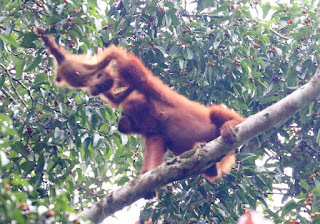 |
| Concentration required when driving |
 |
| Our morning view over Lake Kerinci |
Another week in Sumatra and we have made a little progress north - it is such a large and fascinating island. We have now reached Padang where we have stayed for a couple of days while some essential work is being carried out on the Landcruiser. The bushes on the rear springs are in poor condition and a seal on the front steering is leaking, all due to the severity of the potholes in the roads.
Remarkably all the roads here are surfaced, many recently, providing an excellent driving surface, but then many sections are in terrible condition with large sharp edged potholes causing heavy jolts to the suspension. Bizarrely the worst roads tend to be the main roads which carry the heavy lorries. These both break up the surface and in turn make them very slow as they try to avoid the worst of the holes.
 |
| The Gong Stone |
Driving the main roads is frustrating as it is slow and there are always motorcycles weaving in and out of the traffic - concentration is essential. The side roads are fantastic, but often not signposted, or on any of our maps so again we have tried pot luck with some beautiful scenery.
From Bangkalun we have moved some 500kms up the coast to Padang, but have taken in some beautiful mountains, with the benefit of cooler, but wetter, weather.
 |
| Kerinci Volcano dominating the tea plantations |
We spent several days in the Kerinci valley, seeing more 3000 year old carved stones, and climbing another extinct volcano (Gunung Tujuh) to see the lake in the caldera. A steep climb up a muddy and root strewn path led to a beautiful lake surrounded by steep tree clad walls of the old crater. We managed to get down just as a thunderstorm broke. Gunung Kerinci is the highest volcano in S E Asia at 3,800m and dominates the area, with large tea plantations on its flanks.
 |
| Path up Gununh Tujuh |
 |
| Gunung Tujuh Crater Lake |
From Kerinci we headed north on the minor roads eventually moving into the Minang tribal area where their characteristic peaked houses are a key feature of the landscape. As we were wandering along the village looking at the houses a reporter for a local radio station stopped and interviewed us, then spent half an hour showing us around, including arranging for us to visit one of the traditional houses. We later discovered, when visiting the museum in Padang that the piece had been broadcast and our photo and story shared with staff at the museum. There seem to be very few western visitors to Sumatra - everywhere we go we are asked for photos and people want to talk to us - incredibly friendly and welcoming.
 |
| Traditional Minang House |
 |
| Traditional Minang Street with rice drying |
As we drove round the Lake Singkarak area on Sunday morning we were surrounded by motorbikes and pickup trucks packed with people and their dogs - all heading down one narrow road. There must have been hundreds and hundreds of dogs congregating, seemingly for one of their favourite past times of hunting wild boar. The area round the lake is beautiful, terraces of paddy fields amongst coconut palms, all backed by forest rising up the surrounding mountains. It is interesting that as the climate is constant all year round the rice is in every stage of growth, some paddies being ploughed, whilst nearby they are planting, and harvesting from other paddy fields. So good is the climate and so fertile the soil they get three harvests per year.
Parking up that night we were again privileged to have a troupe of Sumatran Surilli Mitred Leaf Monkeys cross near our van and then roost in some nearby trees for the night.
From here we plan to head to Bukit Tinggi and spend some time in the hills and lakes of this most traditional Indonesian cultural area before heading north to Lake Toba.
 |
| Rich decoration on traditional Minang house |
 |
Rice Paddies - notice rice at all stages,
from just planted to ripe for harvest |
 |
| Rice Paddies |
 |
| Sumatran Surilli - Mitred leaf monkey settled for the night |



































